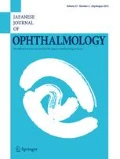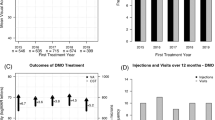Abstract
Purpose
To describe treatment patterns in patients diagnosed with neovascular age-related macular degeneration (nAMD), retinal vein occlusion (RVO), or diabetic macular edema (DME), newly-treated with anti-vascular endothelial growth factor (anti-VEGF) agents as recorded in the Japanese Medical Data Center (JMDC) database.
Study design
This non-interventional, descriptive, retrospective, observational cohort study included insured Japanese patients aged ≥ 21 and ≤ 75 years at index date (anti-VEGF treatment initiation).
Methods
Patients with minimum one claim in JMDC database with a diagnosis code for nAMD, RVO, or DME between October 2007–May 2015 and with minimum of one claim for anti-VEGF agents on or after the date of diagnosis were included. Frequency and proportion of claims submitted for anti-VEGF injections were assessed during 12 months post-index date.
Results
The median (interquartile range) number of claims for anti-VEGF injections during 12 months post-index date were 3 (1, 4) for nAMD (n = 255), 2 (1, 3) for RVO (n = 223) and 2 (1, 4) for DME (n = 125) patients. Frequencies of nAMD, RVO and DME patients with one or more claims for a retinal disease treatment other than an anti-VEGF agent were 4 (1.57%), 59 (26.46%) and 68 (54.40%) during the 12 months pre-index date and 21 (8.24%), 85 (38.12%) and 62 (49.60%) in the 12 months post-index date, respectively.
Conclusions
The median number of anti-VEGF injections per patient was lower than those reported in clinical trials. Although various pre- and concomitant treatments were used in RVO and DME, anti-VEGF monotherapy was the first-line treatment in > 90% of nAMD patients.







Similar content being viewed by others
References
Iida T, Narimatsu A, Adachi K, Wang EC. Anti-vascular endothelial growth factor outpatient treatment patterns in patients with exudative age-related macular degeneration from a Japanese hospital claims database. J Health Econ Outcomes Research. 2014;2:41–52.
Kimura S, Sato T, Ikeda S, Noda M, Nakayama T. Development of a database of health insurance claims: standardization of disease classifications and anonymous record linkage. J Epidemiol. 2010;20:413–9.
Honda S, Matsumiya W, Negi A. Polypoidal choroidal vasculopathy: clinical features and genetic predisposition. Ophthalmologica. 2014;231:59–74.
Brown DM, Campochiaro PA, Bhisitkul RB, Ho AC, Gray S, Saroj N, et al. Sustained benefits from ranibizumab for macular edema following branch retinal vein occlusion: 12-month outcomes of a phase III study. Ophthalmology. 2011;118:1594–602.
Campochiaro PA, Brown DM, Awh CC, Lee SY, Gray S, Saroj N, et al. Sustained benefits from ranibizumab for macular edema following central retinal vein occlusion: twelve-month outcomes of a phase III study. Ophthalmology. 2011;118:2041–9.
Holz FG, Amoaku W, Donate J, Guymer RH, Kellner U, Schlingemann RO, et al. Safety and efficacy of a flexible dosing regimen of ranibizumab in neovascular age-related macular degeneration: the SUSTAIN study. Ophthalmology. 2011;118:663–71.
Ishibashi T, Li X, Koh A, Lai TY, Lee FL, Lee WK, et al. The REVEAL Study: Ranibizumab Monotherapy or Combined with Laser versus Laser Monotherapy in Asian Patients with Diabetic Macular Edema. Ophthalmology. 2015;122:1402–15.
Massin P, Bandello F, Garweg JG, Hansen LL, Harding SP, Larsen M, et al. Safety and efficacy of ranibizumab in diabetic macular edema (RESOLVE Study): a 12-month, randomized, controlled, double-masked, multicenter phase II study. Diabetes Care. 2010;33:2399–405.
Rosenfeld PJ, Brown DM, Heier JS, Boyer DS, Kaiser PK, Chung CY, et al. Ranibizumab for neovascular age-related macular degeneration. N Engl J Med. 2006;355:1419–31.
Silva R, Berta A, Larsen M, Macfadden W, Feller C, Mones J, et al. Treat-and-Extend versus Monthly Regimen in Neovascular Age-Related Macular Degeneration: Results with Ranibizumab from the TREND Study. Ophthalmology. 2018;125:57–65.
Ranibizumab - Novartis Ophthalmics - AdisInsight. https://adisinsight.springer.com/drugs/800011595. Accessed 26 Aug 2020
Aflibercept - Bayer/Regeneron Pharmaceuticals/Sanofi - AdisInsight. https://adisinsight.springer.com/drugs/800013847. Accessed 26 Aug 2020
Bernard AG, Girmens JF, Kodjikian L, Fajnkuchen F, Creuzot-Garcher C, Massin P et al. Real-life Outcomes of ranibizumab 0.5 mg treatment in patients with visual impairment due to Macular Edema secondary to Retinal Vein Occlusion: 6-month results from the 24-month BOREAL-RVO Study [abstract]. MACULART meeting; Paris, 2017.
Chong V. Ranibizumab for the treatment of wet AMD: a summary of real-world studies. Eye (Lond). 2016;30:270–86.
Holz FG, Tadayoni R, Beatty S, Berger A, Cereda MG, Cortez R, et al. Multi-country real-life experience of anti-vascular endothelial growth factor therapy for wet age-related macular degeneration. Br J Ophthalmol. 2015;99:220–6.
Kim LN, Mehta H, Barthelmes D, Nguyen V, Gillies MC. Metaanalysis of Real-World Outcomes of Intravitreal Ranibizumab for the Treatment of Neovascular Age-Related Macular Degeneration. Retina. 2016;36:1418–31.
Kodjikian L, Collet AL, Dot C, Le Lez ML, Baillif S, Erginay A et al. Real-word outcomes with ranibizumab 0.5 mg in treatment-naïve patients with visual impairment due to diabetic macular edema: 12-month results from the ETOILE study [abstract]. MACULART; Paris, 2017.
Pearce I, Parikh S, Macfadden W. Real-world outcomes of ranibizumab in patients with retinal vein occlusion [abstract]. Hawaii: ARVO; Honolulu; 2018.
Holz FG, Figueroa MS, Bandello F, Yang Y, Ohji M, Dai H, et al. Ranibizumab treatment in treatment-naive neovascular age-related macular degeneration: Results From LUMINOUS, a global real-world study. Retina. 2020;40:1673–85.
Mitchell P, Sheidow TG, Farah ME, Mahmood S, Minnella AM, Eter N, et al. Effectiveness and safety of ranibizumab 0.5 mg in treatment-naive patients with diabetic macular edema: Results from the real-world global LUMINOUS study. PLoS ONE. 2020;15:e0233595.
Pearce I, Clemens A, Brent MH, Lu L, Gallego-Pinazo R, Minnella AM, et al. Real-world outcomes with ranibizumab in branch retinal vein occlusion: The prospective, global. LUMINOUS study PLoS One. 2020;15:e0234739.
Ogura Y, Shiraga F, Terasaki H, Ohji M, Ishida S, Sakamoto T, et al. Clinical practice pattern in management of diabetic macular edema in Japan: survey results of Japanese retinal specialists. Jpn J Ophthalmol. 2017;61:43–50.
Shono M, Okuyama T, Miyagishima K. Safety and efficacy evaluation of intravitreal ranibizumab injection for macular edema associated with retinal vein occlusion: interim results of a special drug use-results survey. Yakuri to Rinsho. 2017;27:81–107 ((in Japanese)).
Shono M, Okuyama T, Miyagashima K. Safety and efficacy evaluation of intravitreal ranibizumab injection for macular edema associated with diabetic macular edema: interim results of a special drug use-results survey. Yakuri to Rinsho. 2017;27:109–23 ((in Japanese)).
Kume A, Ohshiro T, Sakurada Y, Kikushima W, Yoneyama S, Kashiwagi K. Treatment Patterns and Health Care Costs for Age-Related Macular Degeneration in Japan: An Analysis of National Insurance Claims Data. Ophthalmology. 2016;123:1263–8.
Suissa S, Garbe E. Primer: administrative health databases in observational studies of drug effects–advantages and disadvantages. Nat Clin Pract Rheumatol. 2007;3:725–32.
Kawasaki R, Konta T, Nishida K. Lipid-lowering medication is associated with decreased risk of diabetic retinopathy and the need for treatment in patients with type 2 diabetes: A real-world observational analysis of a health claims database. Diabetes Obes Metab. 2018;20:2351–60.
Nishimura R, Kato H, Kisanuki K, Oh A, Hiroi S, Onishi Y, et al. Treatment patterns, persistence and adherence rates in patients with type 2 diabetes mellitus in Japan: a claims-based cohort study. BMJ Open. 2019;9:e025806.
Nishimura R, Kato H, Kisanuki K, Oh A, Onishi Y, Guelfucci F, et al. Comparison of persistence and adherence between fixed-dose combinations and two-pill combinations in Japanese patients with type 2 diabetes. Curr Med Res Opin. 2019;35:869–78.
Tanaka S, Seto K, Kawakami K. Pharmacoepidemiology in Japan: medical databases and research achievements. J Pharm Health Care Sci. 2015;1:16.
Diabetic Retinopathy Clinical Research Network, Elman MJ, Aiello LP, Beck RW, Bressler NM, Bressler SB, et al (2010) Randomized trial evaluating ranibizumab plus prompt or deferred laser or triamcinolone plus prompt laser for diabetic macular edema. Ophthalmology. 117; 1064–77 e35.
Heier JS, Campochiaro PA, Yau L, Li Z, Saroj N, Rubio RG, et al. Ranibizumab for macular edema due to retinal vein occlusions: long-term follow-up in the HORIZON trial. Ophthalmology. 2012;119:802–9.
Acknowledgments
The authors thank Shridevi Venkataramani and Lakshmi Venkatraman (Scientific Services Practice- Product Lifecycle Services, Novartis Healthcare Pvt. Ltd., Hyderabad, India) for their medical writing and editorial assistance towards the development of this manuscript.
Funding
The study was sponsored by Novartis Pharma, K.K., Tokyo, Japan. The sponsor participated in the design of the study, conducting the study, data collection, data management, data analysis, interpretation of the data, preparation, review and approval of the manuscript.
Author information
Authors and Affiliations
Corresponding author
Ethics declarations
Conflicts of interest
Y. Ogura, Consultant fee (Novartis, Bayer, Alcon, Wakamoto, HOYA, Astellas, Senju), Lecture fee (Santen, Kowa, Novartis, Bayer, Topcon, Nikon, Sanwa Kagaku Kenkyusho, Boehringer Ingelhein, Otsuka); R. Kawasaki, Consultant fee (Novartis, Bayer, Roche, Senju), Lecture fee (Novartis, Bayer, Senju, Astellas, Novo Nordisk, Santen, Kowa, Takeda, Pfizer, Topcon, Nitto Medic); M. Bauer, Employee (Novartis); V. Bezlyak, Employee (Novartis).
Data sharing
Novartis is committed to sharing with qualified external researchers, access to patient-level data and supporting clinical documents from eligible studies. These requests are reviewed and approved by an independent review panel on the basis of scientific merit.
The data that support the findings of this study are available from JMDC Inc. but restrictions apply to the availability of these data, which were used under license for the current study and so are not publicly available. Data are however available from the authors upon reasonable request and with permission of JMDC Inc.
Additional information
Publisher's Note
Springer Nature remains neutral with regard to jurisdictional claims in published maps and institutional affiliations.
Corresponding author: Yuichiro Ogura
Supplementary Information
Below is the link to the electronic supplementary material.
About this article
Cite this article
Kawasaki, R., Bauer, M., Bezlyak, V. et al. Treatment patterns for retinal diseases in patients newly-treated with anti-VEGF agents: A retrospective analysis of claims data from the Japan Medical Data Center database. Jpn J Ophthalmol 65, 215–226 (2021). https://doi.org/10.1007/s10384-020-00802-8
Received:
Accepted:
Published:
Issue Date:
DOI: https://doi.org/10.1007/s10384-020-00802-8




